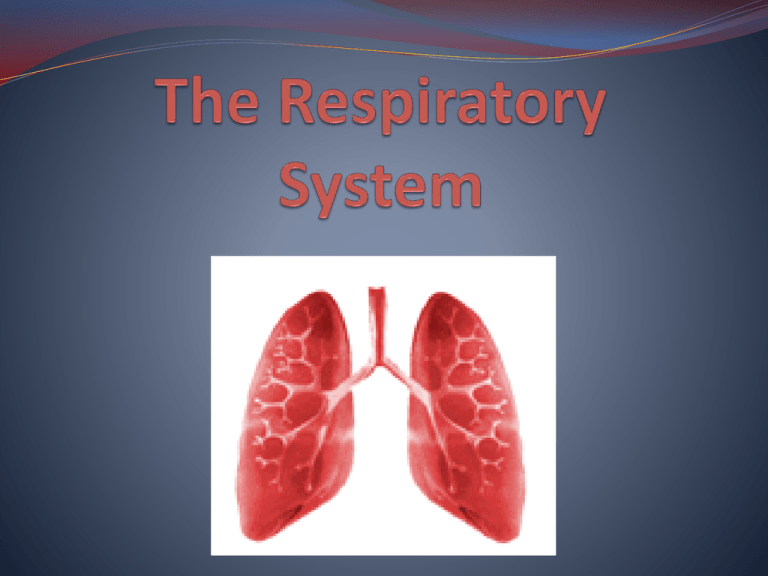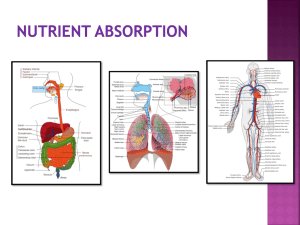The Respiratory System
advertisement

The Respiratory System Respiration taking in O2 (oxygen) and releasing CO2(carbon dioxide). Other functions include inhaling and exhaling, and conditioning the air entering the body. Air is warmed by blood vessels. The Overall Respiratory System Labelled Pleural Membrane Diaphragm The Respiratory System – Flow of Air Air enters in through the nasal passage. Dust is filtered out by hairs (called cilia) and mucus. Air is also warmed in this region Air also enters in through the mouth Air passes through the pharynx (located at the back of the mouth) to the trachea and into the lungs. The larynx is made of cartilage rings and is lined with cilia Cilia and Mucous Cilia are hair like projections used to capture bacteria and/or dust particles Cilia can be found in the linings of nasal passageway, trachea, bronchi, and bronchioles. Mucous is also located in these regions The Larynx The larynx is the enlarged portion of the trachea; contains muscular vocal cords. Vibrations are mixed with air to produce sound. The larynx, known as the voice box The vocal cords are made of folded structures. While breathing, the vocal cords a spread far apart When the vocal cords are brought together they create vibrations as air passes Sound is made Larynx – How Sound is Made (Video) The Respiratory System – Flow of Air The epiglottis is located at the top of the trachea. When you swallow, it closes so that food cannot enter your trachea. From the trachea, air enters the bronchi and then into the small extensions called the bronchioles. The bronchioles are no longer made up cartilage but rather they consist of soft spongy tissue What Happens When You Fluid goes down the wrong pipe? When food or liquid is consumed and it enters into the trachea instead of the esophagus Known as pulmonary aspiration The cilia in the trachea will move the food/liquid in the opposite direction The diaphragm also helps to reverse the process Video: Epiglottis Preventing Choking Larynx to Trachea The Respiratory System – Alveoli Bronchioles branch into smaller alveoli. This is where gas exchange with blood occurs. The blood receives O2 and releases CO2 through the capillaries, in a process called diffusion. Air Flow Chart Pharynx Trachea Bronchus Bronchiole Alveoli Breathing What is air composed of? Inhalation The process of taking air into the lungs Occurs when air pressure outside the body is greater than inside Diaphragm and intercostals muscles contracts creating more space in lungs this creates low pressure Diaphragm moves down Rib cage moves up and out Exhalation The process of taking air out of the lungs Occurs when air pressure inside the body is greater than outside Diaphragm and intercostals muscles relaxes creating less space in lungs this creates high pressure Rib cage moves down and in Diaphragm moves up Inhalation and Exhalation The Respiratory System – Breathing Constructing A Model Lung Using Simple Materials - Demo Exhalation vs. Inhalation Video Clip High Altitude Breathing At high altitudes, the air pressure is lowered and thus thinner than at sea level Oxygen and other gases are present in the air at equal amounts, however there is less air in general. Breathing at these altitudes can be difficult since a lack of oxygen is entering the body The result is a condition known as hypoxia (low oxygen) High Altitude Breathing Altitude sickness often results from moving to high altitudes and not adjusting to the air In response to low air, the body increases the breathing rate which helps to bring in more oxygen to the alveoli. Adapting to Low Oxygen After approx. two weeks, individuals will adapt to low oxygen levels by producing more red blood cells. Individuals living at high altitudes have even evolved to contain more alveoli and more lung capillaries. Case Study: Athletes In the 1968 Olympics in Mexico (~7000ft alt.), short explosive events such as the 100-400m dash, produced record-breaking levels whereas endurance events were well below expectations. How can these results be explained? At high altitudes, the air is less dense thus allowing for less resistance. At high altitudes, there is less air causing more rapid fatigue 5 minute break Respiratory Impairment Drowning: Laryngospasm: The larynx closes and death occurs by asphyxiation (choking) Fresh water: Water wipes away lipoprotein surrounding the alveoli alveoli collapse no gas exchange Salt water: Water leaves blood and fills lungs oxygen cannot reach alveoli Carbon Monoxide (CO) Poisoning: CO binds to the oxygen receptors in the red blood cells more tightly than oxygen Prevents oxygen from entering blood Respiratory Impairment Air Pollution: Includes airborne pollutants such as carbon monoxide, nitrogen oxides, chlorine, methane, and dust particles Can lead to aggravated immune systems asthma Smoking Statistics By 2030, if current trends continue, smoking will kill one in six people. Every eight seconds, someone dies from tobacco use. About 15 billion cigarettes are sold daily - or 10 million every minute. Among young teens (aged 13 to 15), about one in five smokes worldwide. Between 80,000 and 100,000 children worldwide start smoking every day - roughly half of whom live in Asia. Activity: Smoking Use/share a smartphone and quickly research one harmful chemical in cigarettes Smoking Smoking primarily damages cilia Recall: Cilia helps filter out harmful bacteria and dust particles Cigarette smoke has over 1000 times the level of carbon monoxide that is known to be harmful to human health. Cigarette smoke contains 4000 chemicals 40 of which increase the incidence of cancer List of Harmful Chemicals Discussion Homework Pg. 447 # 10-12







